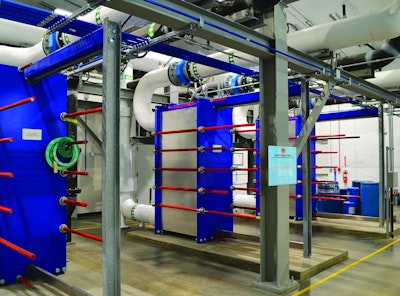
The National Western Center built this central utility plant next to a buried sewer line. Heat exchangers inside transfer heat from waste- water to a closed loop that supplies heated water to several buildings.
Interested in Energy?
Get Energy articles, news and videos right in your inbox! Sign up now.
Energy + Get AlertsA land-use issue at a historic site in Denver led to a huge thermal energy recovery project that benefits both that site and the wastewater utility.
The National Western Center, which leases and operates the property that was once the Denver Stockyards, wanted to open its waterfront along the South Platte River. Its leaders approached Metro Water Recovery, operator of the nearby wastewater treatment plant, about burying the above-grade 72-inch sewer lines along the riverfront.
The initial response was cool — literally — because the lines were placed above ground to dissipate heat in the wastewater stream.
Brad Buchanan, CEO of the National Western Center, recounted how the dilemma was solved.
“A smart engineer and some folks from Colorado State University asked whether there was a way to capture the heat in the line and make use of it while solving both of our problems: creating green heating and cooling for the campus and helping to reduce the temperature of the wastewater.”
That sparked a long process leading to a system that provides 100% of the heat and cooling for some of the new buildings at National Western Center. It also fulfills a large share of the HVAC needs of another building; when expanded it will also help heat and cool other new buildings under construction or being planned.
The system was built by a consortium that includes CenTrio Energy, AECOM Technical Services and Denver-based Saunders Construction.
HEAT EXCHANGE
First the sewer pipes were buried, but part of the flow was diverted to a central utility plant built by the NWC. The diverted flow is connected to heat exchangers (Alfa Laval), in turn connected to a 30-inch HDPE pipe that is part of a closed loop through which water flows from the utility building to the NWC campus.
The water in the closed loop absorbs heat from the sewage. The buildings on the campus have heat pumps that extract the heat, amplify it and transfer it to a forced-air system. The wastewater pipe goes through a Shark macerating pump (Zoeller Pump Company) to break down solids that might foul the heat exchangers. The solids and wastewater then flow back into the sewer system.
Both organizations benefit. NWC gets heat in winter and cooling in summer. Metro Water Recovery gains by reducing the temperature in the part of its raw wastewater flow that is routed through the heat exchangers by about 10 degrees F in winter. There are other economic benefits even though NWC does not pay the utility for the heat.
“Wastewater thermal energy use and district energy systems help us drive toward our vision of a sustainable future for our communities,” says Tanja Rauch-Williams, chief innovation officer for Metro Water Recovery.
“There is an indirect benefit to Metro and our customers since future regulations will require us to lower temperatures in the effluent during certain times of the year. Beneficial use of the thermal energy in wastewater will help minimize the capital investment required to meet those future regulations.”
EXCEEDING EXPECTATIONS
The system has operated since April 2022. Heat transfer, ambient loop line efficiency, and thermal energy losses out of the ambient loop have all been better than expected, according to Buchanan. The only bad news is that more solids than anticipated need to be removed upstream from the heat exchangers. The main culprit is wipes.
NWC sized its central utility plant to accommodate more heat exchangers as new buildings go up on the campus. Although the heat exchangers are mechanical, the system requires power to run the macerators and to pump the water through the clean-water loop.
The line runs about 3,500 feet from the central utility plant to the campus and back. The heat pumps at the buildings require power, and there are backup boilers and evaporative coolers. Nevertheless, the economic benefit of capturing heat from the wastewater is substantial.
“We did some extensive financial analysis, looking at the total cost of ownership,” Buchanan says. “You can’t just look at energy costs. You have to look at maintenance, labor, equipment replacement, everything fully loaded.
“Basically, it’s a 40-year payback. At 40 years, we will own the system free and clear. It becomes a much more attractive investment at that point. It’s probably better than that because energy prices have increased more than our model predicted.”
Flow and temperature data are collected in the central utility plant and along the ambient loop.
“The science behind this is pretty basic,” Buchanan says. “It’s similar to a geothermal system, but the operation is very sophisticated. The entire system is operated remotely from a center in Houston. There’s a very low labor requirement to operate the system.”
VIABLE ENERGY SOURCE
In winter, the heat exchangers take heat out of the wastewater stream, but in summer, when the ambient loop is used to cool the campus buildings, the heat exchangers can transfer heat into the wastewater stream. That is all right with Metro. “Metro’s discharge permit would require cooling the effluent only in winter, and the potential increase in wastewater temperature during summer is not a problem,” says Rauch-Williams.
In fact, Metro is seeking other organizations to develop similar systems to use the thermal energy from the wastewater stream.
“The payback on these systems is becoming very competitive over their lifetime at a larger commercial building scale, in district energy systems and in new construction or substantial building modifications,” says Rauch-Williams. “It’s a viable and renewable energy source running right beneath our cities.”






